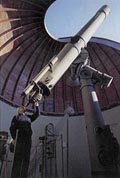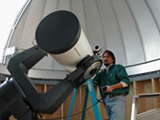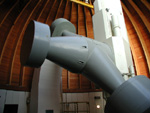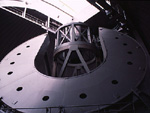equatorial mounting
An equatorial mounting is a telescope mounting with one axis, called the polar axis, that is parallel to Earth's rotation axis, and the other, called the declination axis, at right angles to it. The telescope moves north-south about the declination axis and east-west about the polar axis. To point point at a target requires moving the telescope about both axes. To track a target, however, requires movement about the polar axis only, at the same rate that Earth spins. This is the chief advantage of the equatorial mounting: the N-S position doesn't change, and a single drive can regulate the E-W tracking. The main drawback is that the polar axis is difficult to orientate with respect to the ground, and it is different for every observatory. Positioning the mounting at odd angles creates difficulties that increase rapidly as the size and mass of the telescope increase. For this reason, computer-controlled altazimuth mountings are now used exclusively for new large instruments. Several designs of equatorial mounting have been used extensively over the years:
German mounting
 |
In this approach, the declination axis is at the end of the polar axis, which is on top of a pier to raise the telescope to a convenient height. This arrangement can point to any part of the sky, but it results in a lot of mechanical stress because the weight of the telescope has to be held at the end of the axis. A counterweight is used to balance the telescope on the declination axis, but this doubles the weight that the polar axis must support and limits the German mounting to relatively small, light telescopes.
fork mounting
 |
In this scheme, the polar axis branches into a fork, while the declination axis holding the telescope is anchored on both ends by the two sides of the fork. This provides much stronger declination support for the telescope, but there is still no support for the weight at the end of the polar axis. In addition, there is limited room for the telescope at the bottom of the fork. Either the telescope can have only a small tube if it is to view all parts of the sky, or it cannot view along the polar axis if it is used with larger tubes. The fork was used for telescopes up to mirror diameters of 2.5 meter.
English mounting
 |
In this design, the polar axis is supported at the top and the bottom on vertical piers. This relieves the stress on the polar axis but transfers it to the declination axis. The English mounting isn't restricted to just part of the sky, as in the case with the fork, but it is convenient for only half of the sky at one time. For one half of the sky the telescope is slung beneath the polar axis, making it easy to reach the focus for observing. For the other side of the sky, however, the telescope is on top of the polar axis, making it difficult to reach the focus, except by standing on a tall ladder. The difficulty can be solved by reversing the side of the polar axis on which the telescope is attached, but this only swaps the sides of the sky that the telescope can view easily.
horseshoe mounting
 |
A solution to the problem of supporting telescopes larger than 2.5 meter; it was introduced with the Hale Telescope in the late 1940s and used for all the 3- to 5-meter telescopes built from 1950 to 1970. The Canada-France-Hawaii Telescope, finished in the early 1970s, was one of the last telescopes built to this plan. The fork-like polar axis is mounted on the top end to a horseshoe-shaped support. The fork provides support for both ends of the declination axis, and the horseshoe mount provides support at the top end of the polar axis. Because the horseshoe is open, the telescope can be tilted down all the way to see objects that lie directly along the polar axis in the sky. For every mount, the pier(s) on which the polar axis rests are separate from the floor and the remainder of the observatory building. The piers extend down through the building and into the ground, down to the level of solid rock. In this way, the telescope is isolated from any vibrations in the observatory building.


